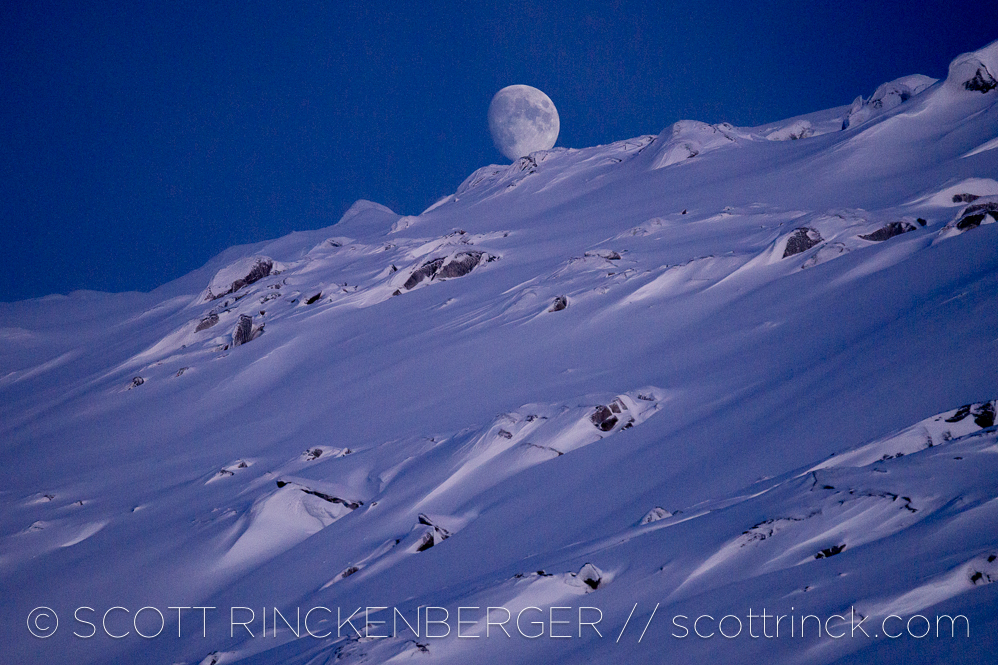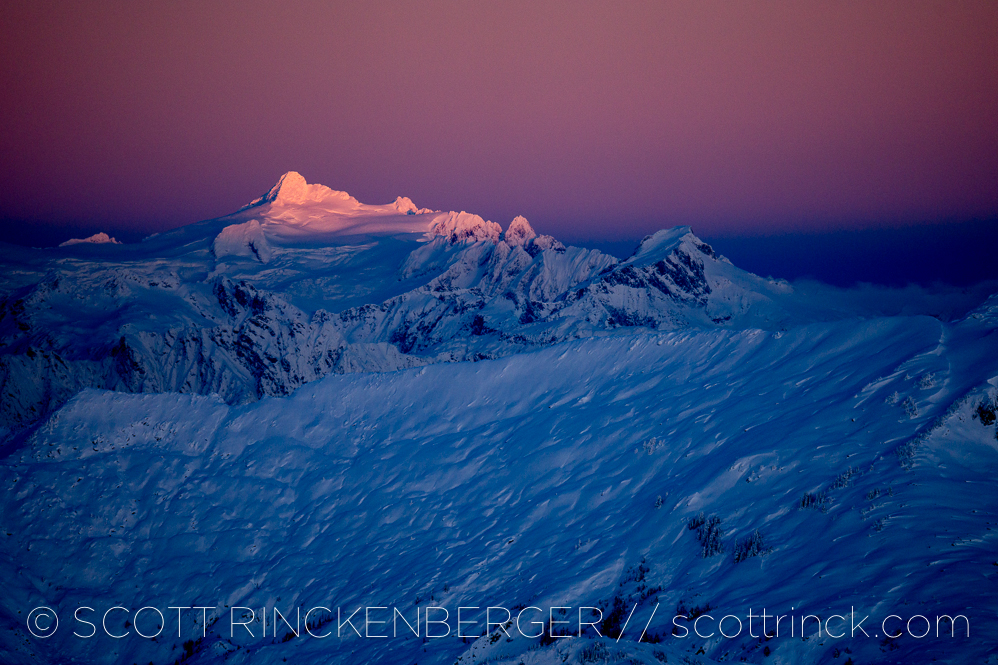Sony rocked the world when it introduced the Alpha A99 at Photokina in September of 2012. The first full-frame SLR using the company's unique translucent-mirror technology, the Sony A99 wowed us in the lab and in the field, proving it had the chops to duke it out with Canon and Nikon in the full-frame arena -- even winning a few rounds in the process. It packs into its modestly priced FF body an unprecedented range of features -- many of them entirely unique to Sony, others unique at the price point.
Given the Sony A99's importance in the market, we wanted to get a pro's take on it, so we commissioned photographer and extreme skier Scott Rinckenberger to put it through its paces in some very harsh environments. And, as you'll see (below), he took some stunning images with the camera.
Scott's photos were so good, in fact, that we felt they -- and the A99 -- deserved something far better than our normal review layout to showcase them. So we developed a new review format you see here. This is just an early design experiment as we look to improve your reading experience. We're pretty thrilled with the results, but we want you -- our valued readers -- to let us know what you think!
Now, on to Scott's account of his time with the Sony A99.
--Dave Etchells 1/22/2013
Pro Review
From coast to Cascades Scott Rinckenberger pushes the Sony A99 to the extremesI am not a camera reviewer by trade. The very idea of framing up an image on a tripod and shooting every possible ISO makes my skin crawl. So, why then would you continue reading a review from yours truly on the recently released Sony Alpha A99? Because great images aren't made in test labs under ideal conditions. They are real moments, often brief and fleeting captured in the world around us. I love this pursuit. I'm a photographer and an outdoor adventurer, completely focused on images and only interested in technology as a means by which to create. When the technology enhances my creativity or improves my execution, I'm in bliss; when it hinders, I look for the shortest route to a device that doesn't.
On paper, Sony's exciting new flagship full-frame camera was enough to pique my interest. It's been billed as a fast shooting, fast focusing, full-frame format, weather-sealed, video friendly, fully customizable camera in a smaller and lighter package than anything else that's come before. It was a similar combination of elements that convinced me to adopt the Sony A77 less than a year ago, a move that I neither regret, nor do I entirely celebrate. For reasons I am unable to articulate, the A77 has always felt one step shy of being a legitimate professional tool, but good enough that when Sony delivered a bigger, better camera -- one tailored to the needs of the working pro -- I decided to give them the benefit of the doubt and give it a go.
As is my habit whenever my schedule allows for self-assigned shooting, I took a good look at the weather, called up a crew of fellow outdoor enthusiasts and made for the wild places of the Pacific Northwest looking for landscapes and action that would challenge my skills and give my camera something to chew on. The first few days found me on the Washington coast shooting surfing and costal landscapes while traveling great distances in an attempt to dodge record-breaking rainstorms. By the following week, the weather had taken a turn for the better resulting in the advent of a new ski season and a foray to a remote backcountry cabin high in the North Cascade mountains for some ski touring and mind-boggling scenery.
“ ” I am also convinced that the electronic viewfinder is a great resource when shooting non-standard exposures as it gives you an incredibly good real-time impression of what your exposure settings will create. See our Sony A99 Technology and Feature Walkaround
First Impressions
The Sony A99 is a solid feeling camera with professional handling and controls on the body that will put a seasoned photographer at ease. Key functions are all handy and (mostly) where you would expect them to be. The LCD screen on the back and the electronic viewfinder in the eyepiece both look crisp and sharp with great detail and color. As a long time Nikon shooter, and the owner of a Sony A77, I was quickly able to navigate both the button layout on the camera's exterior and the deep (and sometimes complex) menus on the inside. In fact, the resemblance to the A77 is uncanny, they're almost identical at a glance. Yet when examined more closely, one finds small tweaks that are pleasing to see. An ISO standard hot shoe, a larger screen, and I dare say, a more robust feel.
Never one to fiddle too much, I set the time and date, my image quality to RAW, my shooting mode to Manual and my focus to AF-D (more on this later), then formatted a SanDisk Extreme Pro SD card and headed for the door.
First Shots
Despite a day of relentless rain, the last hour of the day made a turn for the better as the sun made intermittent appearances from behind the towering rain clouds. High on a bluff above the surf breaks, I mounted the impressive Sony Alpha 70-400mm lens and set out to pick off some action shots of the surfers below, sniper style. Knowing that I needed a fast shutter to stop the action and to isolate camera-shake from shooting handheld at 400mm, I ramped the ISO up to 1600 and set the shutter to 1/1000. I selected the newly introduced AF-D dual phase detect focus which works with the 70-400mm, but surprisingly is not yet supported on the very popular Sony Alpha 70-200mm f/2.8 lens.
The final setting I intended to use turned out to be my first big bummer of using this camera. The 10fps Tele-Zoom setting, which is accessed via the main command dial on the top of the camera, automatically converts the image size to a small jpeg. What?!? I had grown accustomed to making concessions when using the high-speed option on my A77, which requires that you utilize auto exposure instead of my standard manual settings, but the cheaper and smaller A77 still captures a RAW file format at full resolution in high-speed mode.
Perhaps it's my error for not reading the fine print when looking at the frame rates of this camera, but as an action photographer, this came as a bitter blow. Not to be easily defeated, I stuck with my initial RAW file format and settled for the 6fps that is the standard high-speed continuous shooting mode. Later I learned through a fair bit of digging that the 8fps tele-zoom mode (somewhat tricky to find), shoots in RAW format at about 10 megapixels. Nonetheless, that's a big loss of resolution for a small frame-rate gain.
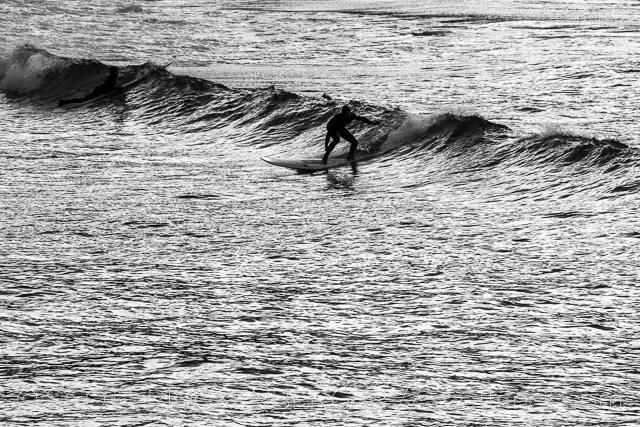 Surfing the last waves of the evening. Shot with the 70-400 f4-5.6 G Lens at 400mm. 1/1000 sec at f/5.6, ISO 1600 DNG (adjusted) | ARW (original) | JPG
Surfing the last waves of the evening. Shot with the 70-400 f4-5.6 G Lens at 400mm. 1/1000 sec at f/5.6, ISO 1600 DNG (adjusted) | ARW (original) | JPG
I spent the latter part of the evening shooting some long exposures using a tripod and the 2-second self timer to keep the camera from wiggling when I released the shutter. I was very pleased to find a low ISO of 50 which creates very clean images and allowed me to have a great deal of latitude in setting my shutter speed for long exposures.
I am also convinced that the electronic viewfinder is a great resource when shooting non-standard exposures as it gives you an incredibly good real-time impression of what your exposure settings will create. This is a huge advantage -- instead of shooting a 30-second exposure and then waiting for playback to see if your exposure was correct, you're able to see what a 30-second exposure will look like before you even pull the trigger. This goes for normal exposures as well. Select your shutter speed, your aperture and your ISO, and the viewfinder (or LCD screen) will supply a visual of the resulting exposure. Between this and keeping a histogram in your viewfinder while shooting, it's really hard to blow an exposure with this camera.
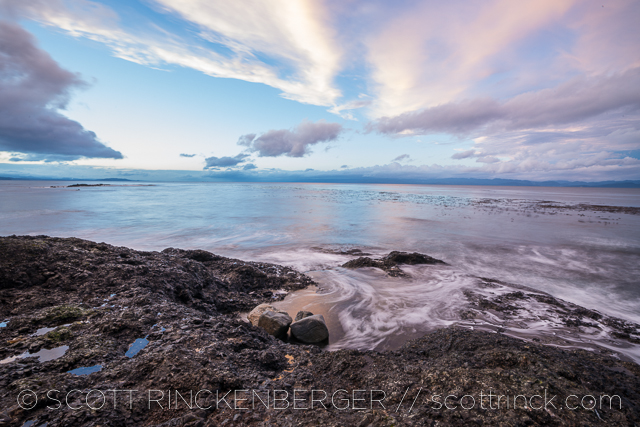 The last colors of sunset reflected in the calm surface of the Pacific. Shot with the 16-35mm f2.8 Z Lens at 16mm. 4 sec at f/22, ISO 50. DNG (adjusted) | ARW (original) | JPG
The last colors of sunset reflected in the calm surface of the Pacific. Shot with the 16-35mm f2.8 Z Lens at 16mm. 4 sec at f/22, ISO 50. DNG (adjusted) | ARW (original) | JPG
Digging Deeper
The following morning at the coast delivered some decent light and small waves which gave me time to play more with the AF-D and Object Tracking with a Wide Focus Area with the 70-400mm lens. The combined effect of these features is a focus grid that looks like a fireworks show. It's total chaos with colored boxes of different sizes popping up all over the place, and while shooting this way, I couldn't have told you a thing about how well the system was working.
But upon review, the images were consistently sharp. The voodoo works, if you've got a compatible lens and your subject is in the middle of the frame.
My next outing was an overnight backcountry ski-tour to a fire lookout high atop a rugged peak in the North Cascade Mountains in Washington. By the time we had organized all of our ski equipment, food and camera gear and driven to the remote trailhead, it was late afternoon, meaning that we'd be climbing a good part of the mountain in the dark.
Where some see a problem, I see a chance to test the high ISO performance of a new camera! So when, at dusk, the moon loomed huge as it rose over a beautiful slope on the eastern horizon, I set the ISO to 3200, zoomed my 70-300mm lens all the way to 300mm, set my shutter speed to 1/125, held my breath, crossed my fingers and pulled the trigger. This is a shot that, by conventional wisdom, you shouldn't be able to capture without a tripod. Well, I got it, thanks to the Sony A99's full-frame sensor and SteadyShot image stabilization!
Later that evening I had occasion to run the ISO all the way up to 12800 as I tried to capture the feeling of the places I was visiting. In my experience, anything upwards of 1600 starts to take on an artsy feel, but to the credit of the A99, the noise was fairly grain-like and not terribly colorful. You might even get some street-cred if you convert these to black and white and send them to an avant-garde photography magazine in Paris. Yet all was not rosy as I pushed into the late night with the A99.
I'll grant this: subjecting a camera to the environmental rigors of the inside and outside of a small fire lookout atop a tall mountain in winter weather at night is a harsh test, but that's exactly what I intended to put this camera through. I was disappointed to experience errors in data transfer to the card, a malfunction of the back screen and even an inactive on/off switch. Each of these problems was temporary and most acute when the camera was subjected to the cold temperature (24º Fahrenheit) and high humidity of the small hut. But needless to say, I'd rest easier if I never saw these technical snags.
On the next day, dawn broke as spectacularly as a dawn can hope to break. Luck and good timing had me cozy in bed in a wonderfully well-kept fire lookout perched poetically atop a rugged and rocky mountain peak. My alarm alerting me to get outside and shoot was well received knowing what waited just steps outside my door.
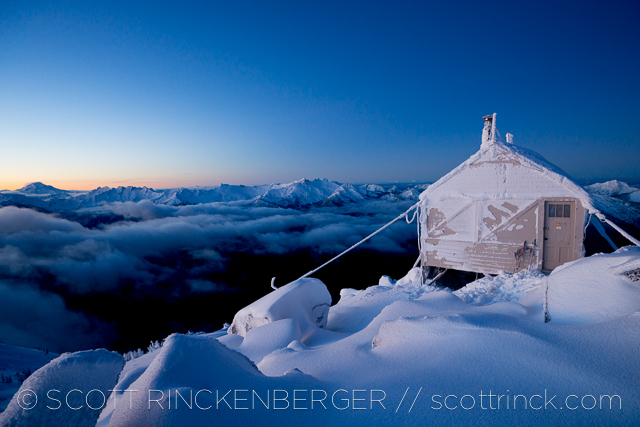 This unlikely and precariously placed structure proved a comfortable and hospitable abode high in the rugged peaks of the North Cascades. Shot with the 16-35mm f/2.8 Z lens at 16mm. Exposure: 2 sec at f/6.3, ISO 400 DNG (adjusted) | ARW (original) | JPG
This unlikely and precariously placed structure proved a comfortable and hospitable abode high in the rugged peaks of the North Cascades. Shot with the 16-35mm f/2.8 Z lens at 16mm. Exposure: 2 sec at f/6.3, ISO 400 DNG (adjusted) | ARW (original) | JPG
For an hour I worked through the process of shooting paradise in absolutely sublime conditions, first with a tripod and long exposures, and eventually handheld as daylight came to full form. The camera performed solidly and the images are a startling reminder of the beauty of nature.
Sony A99: A Fast Performer?
Definitely, compared to full-frame cameras in its general price range, less so against the highest-end competition from Canon & Nikon (at roughly twice the price).
Buffer depth and shooting speed drop a little at higher ISO in the Nikon D800 and D4, while the Canon 6D and 1Dx all lose a little buffer depth and shooting speed at higher ISOs, but none of them to the extent that the A99 does. (We unfortunately don't have a Nikon D600 in the lab anymore, so can't compare the behavior of that obvious competitor.) The D4 and 1Dx also have much deeper buffers, and buffer depth is less dependent on ISO and card speed than in the Sony A99.
Interestingly, we found relatively little impact of aperture on frame rates with the A99, the D800, the D4, and the 6D, but the 1Dx's frame rate dropped from 12 to 7.5fps when going from f/2.8 to f/22. (The 1Dx's electronic aperture actuation doesn't seem as fast as the mechanical actuators in the others, at least with the several lenses we tried on it.)
Bottom line, the Sony A99 is a good bit faster than the 6D and D800 at only modestly higher cost, while the Canon 1Dx and Nikon D4 allow you to shoot about twice as fast, albeit for twice the price.
Before long, my cohorts, a couple of hard charging ski mountaineers, had emerged from the shelter and were chomping at the bit to ski and climb some of the bountiful peaks surrounding our humble abode. Even more excited by the fact that the first run would require only the effort of stepping into our skis and pointing them downhill from the summit-perched hut. I opted for a high angle overlooking the descent from the peak and attempted to shoot the action throughout the duration of the run from top to bottom. It came as a shock to me that while the 6FPS and the AF-D with the SAL24-70 2.8 lens were doing a great job of capturing the action, the buffer of the camera filled extremely quickly and the time it took to clear the buffer resulted in an astounding amount of lost frames. I was more judicious as the second skier dropped into the face, but before he was halfway through his run, I was again stymied by the slow writing process.
A quick detour to present day: I have done some research on this lackluster speed performance, and have subsequently found a few things that will change my experience for the better on my next time out. First, there is a drastic improvement in write speeds when shooting with the very fastest cards available (specifically I've been testing the SanDisk Extreme Pro 95 MB/s card). I had an older Extreme card in the field and it was markedly slower. Also, once you move past about ISO 800, the capture speeds slow significantly as the camera processes and likely runs some noise reduction on the files on their way to the card. And finally, depending on the lens, the smaller aperture you use, the more mechanical steps are at play during the moment of capture, which could also affect the overall speed of shooting. To put all of this into concrete perspective, my metadata showed that I captured 19 images in 23 seconds while shooting the skiing sequence in the field. In stark contrast to this sorry number, I've since experienced speeds up to 57 frames in the same 23 seconds while testing the camera in my office; a full three times as many frames in the same time period! While this still doesn't stand up to the best in action cameras, it's a viable frame rate when the shutter is used with discretion. Given that I was shooting a low ISO (400) and wide open Aperture during the ski sequence, I'll be interested to find out through future experiences the extent to which weather/temperature plays a part in the cameras operating speed.
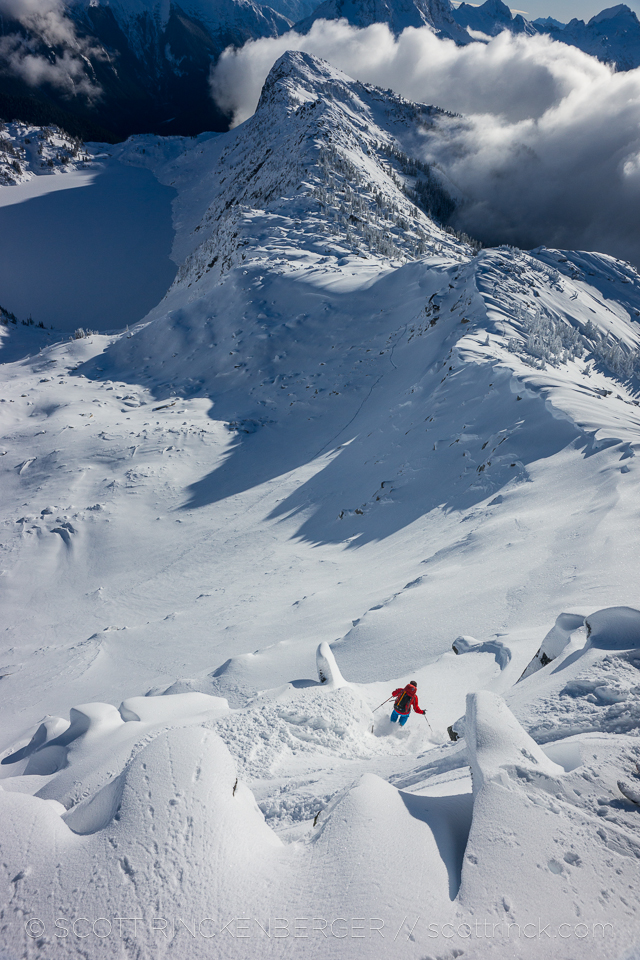 Erik Svege wakes up to steep and deep skiing just footsteps from the front door. Shot with the 24-70mm f/2.8 Z lens at 24mm. Exposure: 1/1000 sec at f/11, ISO 400. DNG (adjusted) | ARW (original) | JPG
Erik Svege wakes up to steep and deep skiing just footsteps from the front door. Shot with the 24-70mm f/2.8 Z lens at 24mm. Exposure: 1/1000 sec at f/11, ISO 400. DNG (adjusted) | ARW (original) | JPG
For the rest of the day we enjoyed perfect weather and great conditions as we explored the mountains and I shot photos like a kid in a candy store. A few tweaks in my approach and a little bit of customization of the camera resulted in a solid partnership between man and device for the duration of the trip. Needless to say, I was excited to get back to my office and see what the partnership had yielded.
“ ” The combination of this great full frame sensor, a handful of top flight lenses, and some magical image stabilization ... yielded a pile of clean, sharp images of a technical quality that will stand up to anything at this price-point or below. See Scott's full set of photos
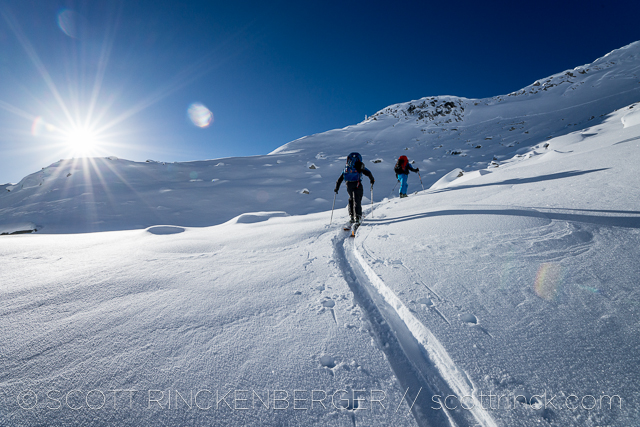 Erik Svege and Brian Fletcher climbing the slopes above Hidden Lake after a beautiful morning powder run. Shot with the 16-35mm f/2.8 Z lens. Exposure: 1/800 sec at f/13, ISO 400.
Erik Svege and Brian Fletcher climbing the slopes above Hidden Lake after a beautiful morning powder run. Shot with the 16-35mm f/2.8 Z lens. Exposure: 1/800 sec at f/13, ISO 400.
DNG (adjusted) | ARW (original) | JPG
Pixel Peeping
In two words: I'm impressed. The combination of the A99's great full-frame sensor, a handful of top flight lenses, and some magical image stabilization in the form of Sony's Steady Shot technology yielded a pile of clean, sharp images of a technical quality that will stand up to anything at this price-point or below. The ISO looks great up to 1600. The dynamic range is really fantastic. Since I shoot exclusively in RAW file formats, I have no comment on the JPEG rendering, and will say that the ARW files come out of the camera a bit flat, both in terms of contrast and color, but this is an ideal state for high quality RAW files, allowing immense latitude for adjustment in post production.
Inveterate pixel peeper? Want studio comparisons of image quality? See our detailed A99 Image Quality Analysis
The Kits
Surf Kit
- Sony Alpha A99 Body
- SAL 16-35Z f/2.8 Lens
- SAL 24-70Z f/2.8 Lens
- SAL 85Z f/1.4 Lens
- SAL 70-400G f/4-5.6 Lens
- 3 Sony NP-FM500H Batteries
- 6 SanDisk SD Cards (16 and 32 GB Extreme and Ultra Cards)
- Giottos VGR8255-S2N Carbon Fiber Tripod
- Lowepro Photo Sport 200 AW
- 15" Apple MacBook Pro
Ski Kit
- Sony Alpha A99 Body
- SAL 16-35Z f/2.8 Lens
- SAL 24-70Z f/2.8 Lens
- SAL 70-300G f/4.5-5.6 Lens
- 6 SanDisk SD Cards (16 and 32 GB Extreme and Ultra Cards)
- 3 Sony NP-FM500H Batteries
- Giottos VGR8255-S2N Carbon Fiber Tripod
- Think Tank Digital Holster 20 V2.0 Bag with Chest Harness
- ThinkTank Lens Changer 25 V2.0
- ThinkTank Lens Changer 50 V2.0
The Good
- Customizable button layouts
- Build quality and handling
- Control layout on camera body
- Focusing with compatible lenses
- 'Steady Shot Inside' internal image stabilization
- High ISO performance
- Overall image quailty
- EVF clarity/resolution
- Screen clarity/resolution
- Display options for shooting and playback
- Articulating screen
- Video Settings up to 60fps at 1080p
The Bad
- Not enough focus points in frame periphery
- Electronic errors in harsh environments
- 10fps Tele Zoom mode only works with small jpegs
- Menus and features are complex to learn
- APS-C lenses auto crop to 10 megapixels
- 8fps Tele Zoom mode crops to 10 megapixels
- No built-in time lapse settings
- Steep learning curve in finding technical particulars
The TBD
- Panoramic Stitch Mode. Since I'm not a huge fan of being forced to shoot in jpeg format, I didn't entertain this setting, but it has a lot of potential in terms of quickly creating a file capable of large format printing.
- Video Performance. The A99 looks to be so potent and impressive a video camera, I didn't feel it appropriate to include that feature set in this review, which was focused on the creation of stills. That said, what I've seen in terms of video and audio is spectacular and will rival any other camera at this price point.
- Endurance/reliability. Of all the nitpicks I have with the Sony A99, far and away the one that concerns me most is the reliability factor. Small temporary glitches on a brand new, full production model were not devastating to my shooting, but they sure were spooky. As this technology and Sony's presence at the high end of photography are both new developments, only time will tell whether their product will stand the test of time that their competitors have passed again and again.
Scott wasn't able to cover the A99 video performance. Want an overview of the Sony A99 video capabilities? Check out our dedicated A99 video page!
My Two Cents
I had two questions in my head when I decided to give the Sony A99 a try. First, is this a competitive entry in the full-frame marketplace? And second, does it stack up well against its pro-level competition?
To the first question, the answer is yes. The camera is an impressive piece of technology which shines in good conditions. The image quality is excellent, the overall control and operation of the camera feels professional, responsive and very customizable. The selection of Sony lenses available for this camera is complete and in the case of the Zeiss lenses, absolutely stellar. For photographers who want the cutting edge of technology and image quality this camera is very much in the running.
To the second question, my answer is a qualified maybe. There are certain things about this camera that will change the paradigm for high-end photography. Image stabilization on the sensor, multiple phase-detect AF sensors,1080/60P video with stereo audio control, uncompressed HDMI output and Translucent Mirror technology are all at the very forefront of photographic technology, and in many ways eclipse the performance of even the top-of-the-line cameras from Canon and Nikon.
On the other hand, I don't believe that this camera matches the high ISO performance or image quality of the Nikon D800, the speed and ease of use of the Nikon D4 or the 61 focus points and large screen of the Canon 5D Mark III. But most importantly, I'm not convinced that it has the build quality and durability to be a daily driver for a professional photographer putting the camera to the test in all conditions. That said, I'm an optimistic guy and a huge fan of the underdog, and nothing would please me more than to be convinced that this camera is a bomb-proof, go-anywhere performer.
The A99 is a camera that I really want to love, but right now, it might feel better if we can just be really good friends. Over time, perhaps that friendship might blossom into something deeper and develop into a long-term committed relationship.
--Scott Rinckenberger
See Imaging Resource's A99 Conclusions and full Pros and Cons

$3300.84 (18% more)
22.3 MP (8% less)
Similar sized sensor
Also has viewfinder
950g (15% heavier)
5% larger
$2714.19
20.2 MP (17% less)
Similar sized sensor
Also has viewfinder
755g (9% lighter)
11% smaller
$2114.34 (24% less)
24.3 MP
Similar sized sensor
Also has viewfinder
1350g (63% heavier)
Similar size
$2731.44
36.3 MP (49% more)
Similar sized sensor
Also has viewfinder
1008g (22% heavier)
14% larger
$2114.34 (24% less)
24.3 MP
Similar sized sensor
Also has viewfinder
1350g (63% heavier)
Similar size
$2731.44
36.3 MP (49% more)
Similar sized sensor
Also has viewfinder
1008g (22% heavier)
14% larger


